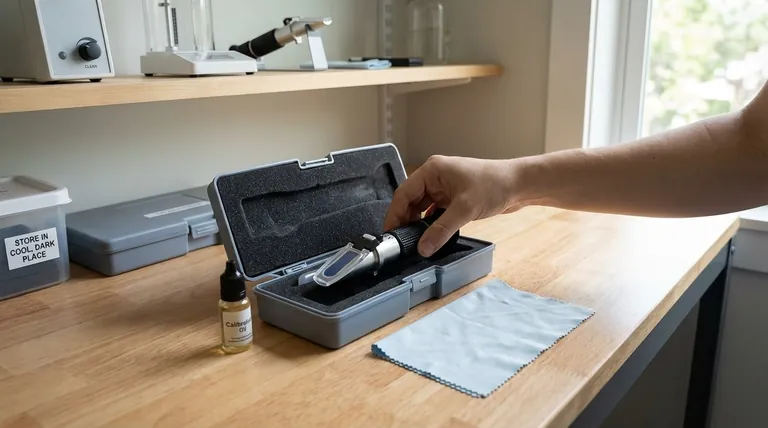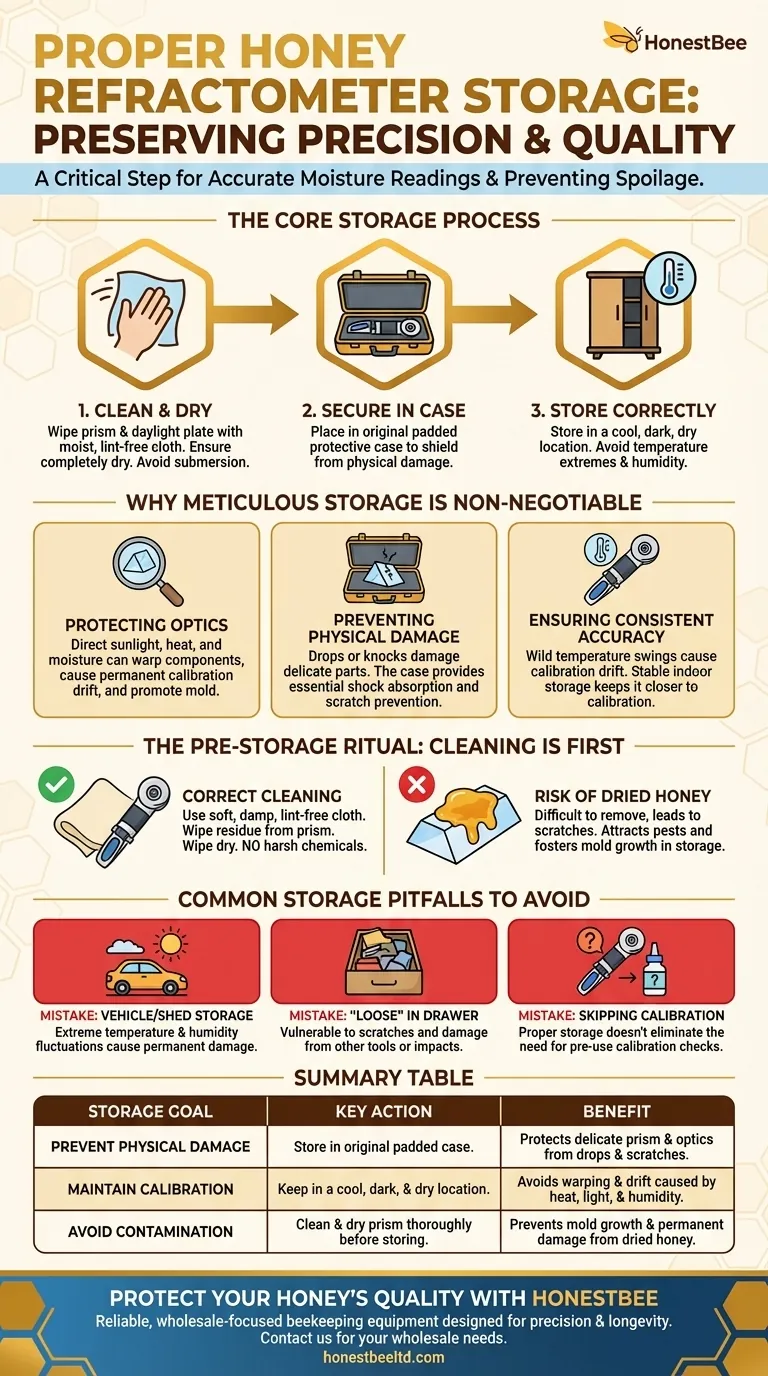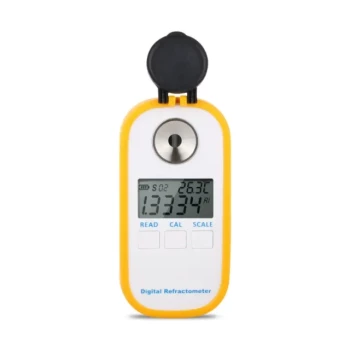To properly store a honey refractometer, you must first clean it with a moist, lint-free cloth and ensure it is completely dry. It should then be placed in a cool, dark, and dry location, ideally within its original protective case, to shield it from physical damage, temperature extremes, and humidity that can compromise its accuracy.
Storing a refractometer is not merely about tidiness; it's a critical step in preserving the instrument's precision. Improper storage directly risks the accuracy of your honey moisture readings, which can lead to fermentation and spoilage.

Why Meticulous Storage is Non-Negotiable
A refractometer is a precision optical instrument. Its environment between uses is just as important as how you handle it during a reading. The goal of storage is to maintain its calibration and physical integrity.
Protecting the Prism and Optics
The heart of the refractometer is its prism assembly. Direct sunlight and high heat can cause materials to expand or contract, potentially warping components and throwing off the instrument's calibration permanently.
Excess moisture is equally damaging. If stored in a damp location or put away while still wet, mold or fungus can grow on the optical surfaces, making the scale impossible to read clearly.
Preventing Physical Damage
Most refractometers are sold with a padded case for a reason. An accidental drop or knock can easily damage the delicate prism, hinge, or eyepiece.
Storing the instrument in its designated case provides essential shock absorption and prevents scratches on the prism glass, which would interfere with accurate readings.
Ensuring Consistent Accuracy
A refractometer is sensitive to temperature. Storing it in an unstable environment, like a vehicle or an outdoor shed, exposes it to wild temperature swings.
While allowing the instrument to acclimate to room temperature before use can correct for minor shifts, extreme fluctuations can cause lasting calibration drift. A stable, indoor storage location ensures it remains closer to its calibrated state.
The Pre-Storage Ritual: Cleaning is First
You cannot properly store a dirty instrument. Cleaning the refractometer immediately after every use is the first and most critical step before it is put away.
The Correct Cleaning Method
Use a soft, damp, and lint-free cloth to gently wipe all honey residue from the prism and daylight plate. Never submerge the refractometer in water, as this can force moisture inside the housing.
Avoid abrasive materials or harsh cleaning chemicals that could scratch the prism's surface. Once clean, wipe it dry with another soft cloth.
The Risk of Dried Honey
Dried honey is difficult to remove and attempting to scrape it off is a common way users permanently scratch the prism.
Furthermore, any leftover honey residue can attract pests or serve as a medium for mold growth inside the case during storage.
Common Storage Pitfalls to Avoid
Even with the best intentions, simple mistakes can lead to a damaged or inaccurate tool. Being aware of these common errors is key to protecting your investment.
Mistake: Leaving it in a Vehicle or Shed
These locations experience the most extreme temperature and humidity fluctuations. The heat in a car on a sunny day is enough to cause permanent damage and calibration loss.
Mistake: Storing it "Loose" in a Drawer
Without its protective case, the refractometer is vulnerable to being scratched by other tools or damaged if the drawer is slammed shut.
Mistake: Skipping Calibration Before Next Use
Proper storage maintains the instrument's condition, but it does not eliminate the need for calibration. Always verify your refractometer's accuracy with a reference solution or calibration oil before taking a critical measurement.
Making the Right Choice for Your Goal
Your storage discipline directly impacts the reliability of your honey analysis. Use this checklist to ensure your instrument remains a trusted tool.
- If your primary focus is longevity: Always store the refractometer in its hard case and place it in a climate-controlled cupboard or drawer to prevent physical damage and thermal stress.
- If your primary focus is immediate accuracy: Always clean the prism immediately after use and re-calibrate the instrument before your next test, regardless of how well it was stored.
- If your primary focus is preventing contamination: Ensure the instrument is completely dry before closing its case to eliminate any risk of mold growth on the optics.
Properly caring for your refractometer is a direct investment in the quality and integrity of your honey.
Summary Table:
| Storage Goal | Key Action | Benefit |
|---|---|---|
| Prevent Physical Damage | Store in the original padded case. | Protects the delicate prism and optics from drops and scratches. |
| Maintain Calibration | Keep in a cool, dark, and dry location. | Avoids warping and drift caused by heat, light, and humidity. |
| Avoid Contamination | Clean and dry the prism thoroughly before storing. | Prevents mold growth and permanent damage from dried honey residue. |
Protect Your Honey's Quality with the Right Equipment
Just as proper storage is critical for your refractometer's accuracy, using high-quality, durable beekeeping supplies is essential for your entire operation's success. HONESTBEE supplies commercial apiaries and beekeeping equipment distributors with reliable, wholesale-focused equipment designed for precision and longevity.
Ensure every tool in your apiary meets the highest standards. Contact our team today to discuss your wholesale needs and discover how our products can support your honey quality and business goals.
Visual Guide

Related Products
- Precision Honey Refractometer Instrument for Quality Assessment
- Digital Honey Refractometer for Precision Measurement of Optimal Honey Quality
- 8-Frame Electric Self-Reversing Honey Extractor Spinner for Commercial Honey Extraction Equipment
- Honey Concentrating Vacuum Heating Thickening Machine Dehumidifier for Honey
- Professional Thermostatic Conical Honey Melter
People Also Ask
- Why is a honey refractometer considered essential for commercial beekeepers? Ensure Honey Quality and Profitability
- Why is a honey refractometer important for beekeepers? Ensure Quality and Prevent Fermentation
- What are the benefits of using a Pocket Digital Honey Refractometer? Achieve Precision & Speed in Honey Quality Control
- What are the features of the Standard Refractometer for honey moisture content? Essential Tools for Quality Control
- What is a honey refractometer and what is its purpose? Ensure Honey Quality and Prevent Spoilage



















